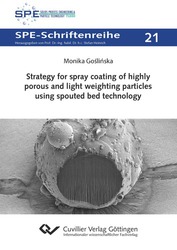| Fachbereiche | |
|---|---|
| Buchreihen (96) |
1378
|
| Nachhaltigkeit |
3
|
| Gesundheitswesen |
1
|
| Geisteswissenschaften |
2364
|
| Naturwissenschaften |
5406
|
| Ingenieurwissenschaften |
1793
|
| Allgemeine Ingenieurwissenschaften | 292 |
| Maschinenbau und Verfahrenstechnik | 862 |
| Elektrotechnik | 686 |
| Bergbau- und Hüttenwesen | 30 |
| Architektur und Bauwesen | 75 |
| Allgemein |
98
|
|
Leitlinien Unfallchirurgie
5. Auflage bestellen |
|
Erweiterte Suche
Strategy for spray coating of highly porous and light weighting particles using spouted bed technology (Band 21)
Monika Goślińska (Autor)Vorschau
Leseprobe, PDF (1,6 MB)
Inhaltsverzeichnis, PDF (45 KB)
In this thesis an in-depth experimental study of the spray coating of light weighting and mesoporous organic aerogels was carried out. The main goal of this study was to design a stable core-shell particle system with a uniform coating layer without changing the initial particle structure. Further, the applied coating layer provides many beneficial improvements and additional properties for the aerogel particles, like an enhanced mechanical stability or a protection against moisture during storage.
To design the structured core-shell particles with unaffected porous structure and uniform coating layer, series of experiments was conducted. The coating process with beeswax and ethanol based shellac solutions was performed at two levels using acoustic levitation and spouted bed set ups. At single particle level the basic influences on particle structure were captured. During coating at multiple particle level, which was performed in spouted bed, the results were validated. The optimum coating process parameters were identified. A uniform and stable core-shell particle system was designed. No change of initial porous particle structure was observed.
| ISBN-13 (Printausgabe) | 9783736977341 |
| ISBN-13 (E-Book) | 9783736967342 |
| Buchendformat | other |
| Sprache | Englisch |
| Seitenanzahl | 196 |
| Umschlagkaschierung | matt |
| Auflage | 1. |
| Buchreihe | SPE-Schriftenreihe |
| Band | 21 |
| Erscheinungsort | Göttingen |
| Promotionsort | Hamburg |
| Erscheinungsdatum | 23.02.2023 |
| Allgemeine Einordnung | Dissertation |
| Fachbereiche |
Maschinenbau und Verfahrenstechnik
|
| Schlagwörter | Coating, spray coating, aerogels, spouted bed, fluidized bed, fluidisation, coating uniformity, encapsulation, alginate aerogels, polysaccharide aerogels, high porosity, ultralight, high surface area, low density, shellac, ethanolic solution, beeswax, melt, carrier material, fine particle, jet cutting, coating uniformity, two-fluid-nozzle, acoustic levitation, statistical analysis, single droplet drying, drying, single particle coating, drying kinetics, first drying period, evaporation rate coefficient, Sherwood model, D2-law, multiple particle coating, material characterization, water vapour permeability, minimum film forming temperature, contact angle, viscosity, surface tension, glass transition, melting point, droplet size, dynamic vapour sorption, particle size distribution, roughness, angle of repose, scanning electron microscopy, coefficient of restitution, design of experiment, food, pharma, functional food, functionalization, secondary coating layer, drug release, Beschichtung, Sprühcoating, Aerogele, Strahlschicht, Wirbelschicht, Ummantelung, Verkapselung, Fluidisation, Alginataerogele, Polysaccharidaerogele, hohe Porosität, Partikel, geringe Dichte, hohe spezifische Oberfläche, sehr leichte Partikel, Schellack, ethanolbasierte Lösung, Bienenwachs, Schmelze, Trägermaterial, Partikel, Beschichtungsgrad, Bedeckungsgrad, Zweistoff-Düse, akustische Levitation, statistische Analyse, Trocknen von Einzeltropfen, Trocknung, Beschichtung von Einzelpartikeln, Trocknungskinetik, erster Trocknungsabschnitt, Verdunstungsrate, Verdunstungsratenkoeffizient, Sherwood-Beziehung, D2-Gesetz, Beschichtung auf multipartikulären Ebene, Materialcharakterisierung, Wasserdampfpermeabilität, Mindestfilmbildungstemperatur, Kontaktwinkel, Viskosität, Oberflächenspannung, Glasübergang, Schmelzpunkt, Tropfengröße, Sorptionsisotherme, Partikelgrößenverteilung, Rauhigkeit, Böschungswinkel, Rasterelektronenmikroskopie, Stoßzahl, DoE, Lebesmittel, Pharma, funktionelle Lebensmittel, Funktionalisierung, sekundäre Coatingschicht, Freisetzungskinetik |
| URL zu externer Homepage | https://www.tuhh.de/spe/home.html |








